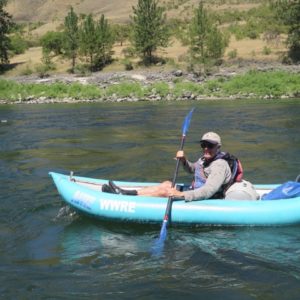Of Rivers and Fires
Last week we had a wonderful experience, rafting the Lower Salmon River in Idaho.
 The Salmon is the longest river without a dam in the U.S. It begins its 425 mile course in the Sawtooth Range of Idaho and flows to its confluence with the Snake River in Hells Canyon. Our four-day, three night trip spanned about 80 miles from Pine Bar to Heller Bar on the Snake.
The Salmon is the longest river without a dam in the U.S. It begins its 425 mile course in the Sawtooth Range of Idaho and flows to its confluence with the Snake River in Hells Canyon. Our four-day, three night trip spanned about 80 miles from Pine Bar to Heller Bar on the Snake.
The Salmon is also known as “The River of No Return.” It is possible to go down this river, but not up it. Ergo, “no return.” Lots of rapids along the way. During the late 19th and early twentieth centuries, traders would build a log raft somewhere in the Sawtooth and head down river, selling goods to farmers and gold prospectors as they traveled. At the end of the trip, they would dismantle the raft, sell the wood and then return overland to do it all again.
 I spent a good deal of the trip in a inflatable kayak (“IK” in river parlance). Most of my kayaking has been on the Puget Sound, i.e. ocean kayaking. This was different, with frequent level three rapids. It all works pretty well if the waves are coming from one direction, but when they come from two or three directions at the same time. Well . . . I was dumped out twice! Was it scary? Honestly, yes. You are “in over your head” in more ways than one! One’s respect for power of water, for the river, is quickly renewed.
I spent a good deal of the trip in a inflatable kayak (“IK” in river parlance). Most of my kayaking has been on the Puget Sound, i.e. ocean kayaking. This was different, with frequent level three rapids. It all works pretty well if the waves are coming from one direction, but when they come from two or three directions at the same time. Well . . . I was dumped out twice! Was it scary? Honestly, yes. You are “in over your head” in more ways than one! One’s respect for power of water, for the river, is quickly renewed.
We traveled, as last year when we on the Snake River, with “Winding Waters River Expeditions” based in Joseph, Oregon. A really great outfit.
It is a privilege to see such country, much of it accessible only from the river. One consequence of there being no dams on the Salmon is that there are sandy beaches at many points along the way. These make great campsites. Linda and I slept out under the stars, able to see the Milky Way.
But such clarity may not last. Back now at our cabin near Wallowa Lake the forecast says that there will be some smoke and haze in the air for at least the next couple days. Given the fires burning in the West that is not a surprise.
But it is not an accident either. In the U.S. we now have five times the number of fires in a season that we had in the 1970’s. With climate change and an overall rise in temperatures, the snowpacks come off earlier and the fire season is much longer than it used to be.
I don’t remember ever getting “smoked out” here in the Wallowas until the last decade. Now it is a frequent, and costly, experience.
Last year the Cycle Oregon Ride scheduled to come through the Wallowas was cancelled at the last minute because of smoke. It was a blow to local business, particularly restaurants. Instead of hundreds of customers, outfits that operate on a tight margin had all sorts of food stockpiled, but no customers. Three restaurants in Joseph folded.
The increase in the frequency and violence of wildfires is but one form of “extreme weather.” Other climate change related extreme weather includes the heavy rainstorms in the Northeastern U.S.
When will we are a nation, and species, really take this seriously? Our capacity for denial is pretty astonishing. Change is happening in the climate, and it has some pretty nasty consequences. It will have other consequences we do not begin to foresee.
While lots of good work is going on in relation to the environment, meeting a challenge like this requires leadership. Given our leadership and the political paralysis in Washington D.C., it is difficult to be optimistic.
![Anthony B. Robinson [logo]](https://www.anthonybrobinson.com/wp-content/themes/anthonybrobinson/images/logo.png)
![Anthony B. Robinson [logo]](https://www.anthonybrobinson.com/wp-content/themes/anthonybrobinson/images/logo-print.png)